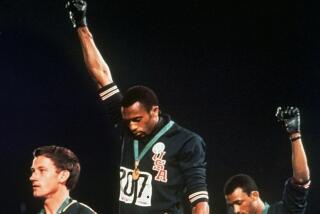AMERICA’S CUP ANALYSIS : Are Kiwis Playing Some Mind Games?
- Share via
SAN DIEGO — Who knows what secrets lurk in the heart of a Kiwi?
Or an Aussie, for that matter.
Among them, New Zealand and the two Australian boats have won one of six races over the first two days of the challenger trials for the America’s Cup, which resume today.
Odd, but Syd Fischer’s Challenge Australia can go 0-2, and nobody blinks. New Zealand goes 1-1 and Spirit of Australia 0-2, and the world is upside down.
Are the lads from Down Under on a mental walkabout? Are they having trouble sailing right side up?
Il Moro di Venezia skipper Paul Cayard raised the point that it seemed to him the Kiwis weren’t trying when he beat them so handily Sunday.
It’s called sandbagging, the name probably deriving from Pheidippides putting rocks in his jock so he wouldn’t look as fast as he really was, thus driving up the odds for his jog from Marathon.
It’s nothing new in sports.
But it is appropriate that the subject would be raised in an event sponsored by a luggage company, although there is not a single sac de sable listed in the Louis Vuitton catalogue.
Did the Kiwis throw the race? Is the skipper Rod Davis or Shoeless Joe Davis? Say it ain’t so, Rod.
If so, why? Why would New Zealand rather lose than win?
The America’s Cup is as much a contest for designers as it is for sailors, and innovations have often carried the day.
It’s not a big problem if the innovation is underwater, but when it’s sticking right out in front, like Cyrano de Bergerac’s schnozz, it’s pretty hard to hide.
See, nobody ever objects to a slow boat being different.
But in this Cup only one boat has a bowsprit, and that boat seems to be fast, so there goes the edge.
The simple solution is to make people think the bowsprit isn’t such a hot idea, after all, and all it costs is one lousy point for a first-round race.
Meanwhile, Sir Michael Fay will try quietly to corner the world market on bowsprits, collect them all and ship them home for storage in the ’56 Zephyr that serves as clubhouse of the Mercury Bay Boating Club.
Davis was stuck in a protest hearing initiated by Il Moro until 10 o’clock Sunday night.
“I thought we weren’t supposed to have protests at this regatta,” he said Monday, referring to the introduction of on-the-water umpiring into the Cup.
He responded to Cayard, point by point, on the series of “uncharacteristic” incidents at the first windward mark when the Kiwis appeared to give the race away.
1) Badly calculating the layline and having to make two extra tacks, while saving Il Moro two tacks: “We just came up short of the layline.” 2) A bear-away spinnaker set instead of a jibe set: “Each race is a learning curve. You learn things about your boat and your opponents’ boat.”
3) Choice of a spinnaker that was smaller than Il Moro’s gennaker: “That probably confused Paul a little. I’ll have to let the world guess on that one.”
4) The “face-to-face, five-minute argument” among the afterguard afterward: “That is totally, unquestionably inaccurate. Five minutes?
“Paul is stirring the pot and throwing as much stuff as he can around and hoping some of it will stick. That’s not characteristic of Paul. We made some mistakes. Things didn’t go according to the plan. We’d much rather have won the race.”
New Zealand was the last team to accuse another of sandbagging in the Cup.
Somehow, in ’88 when Dennis Conner took the headsail down on his catamaran and luffed the main to keep both hulls in the water, the Kiwis thought he was holding something back.
The evidence this time isn’t nearly as clear.
But even in losing to Il Moro Sunday, New Zealand was third fastest around the course that day.
True, the later matches, benefiting from building winds and observations of earlier starters, generally have been faster.
That might explain how Peter Gilmour’s Spirit of Australia was fourth fastest for the day despite losing by 11 minutes to Ville de Paris, and on the first day how Il Moro was next-to-slowest in beating Spirit in the first match and Sweden’s Tre Kronor was second fastest despite losing the final match to Nippon.
Are New Zealand and Spirit trying to hide their speed? Each beat Il Moro to the first mark--a good indicator of speed--before rolling over with their feet in the air.
And against Il Moro, New Zealand was faster on four of the eight legs, suffering its largest setback of 3 minutes 21 seconds on the second windward leg, then losing by 2:14.
Go figure.
Spirit already has begged off its last two first-round matches against Nippon and New Zealand, claiming it needs the time to tinker, so both might escape the round without showing much.
The important matches are later when victories count four points in the second round and eight in the third.
The international jury that considered the bowsprit matter is chaired by Graeme Owens of Britain. Other members are Zvi Ziblat, Israel; Gerard Bosse, France; Masayuki Ishii, Japan, and Graeme Hayward, Canada. They also are serving as umpires.
Sunday night they dismissed Il Moro’s technical protest of how New Zealand uses its bowsprit when jibing a gennaker sail--i.e., by running a sheet (trim adjustment line) through a turning block on the end of an outrigger (the bowsprit), which is illegal.
The Kiwis demonstrated it wasn’t a sheet but a tack control line, just to hold a corner of the gennaker firmly in place.
The jury ruled it’s OK to leave the spinnaker pole detached during a jibe as long as the whole jibing process is continuous and “at a reasonable pace consistent with the prevailing conditions.”
The Kiwis had done their homework.


